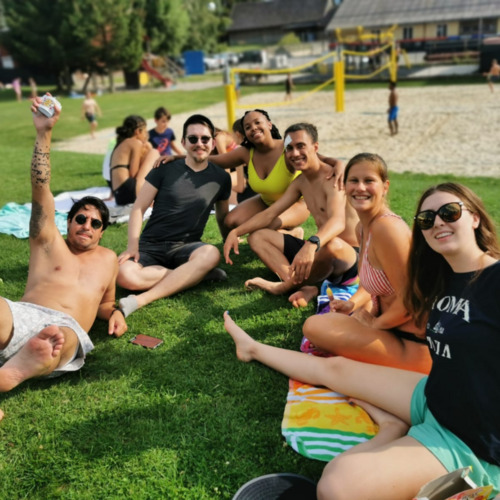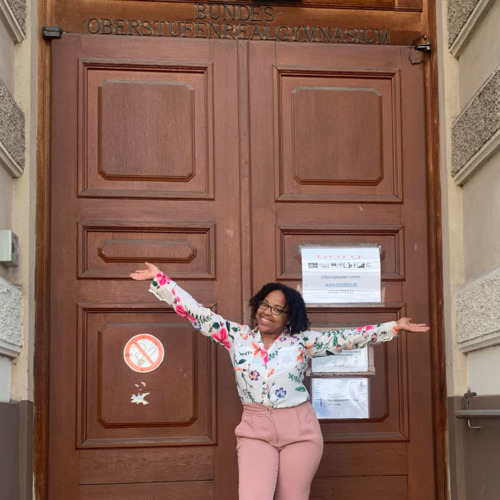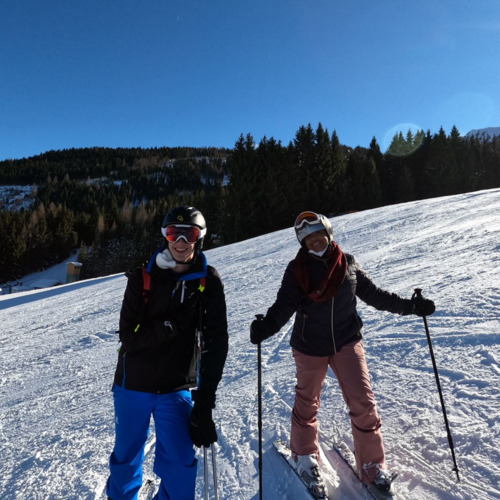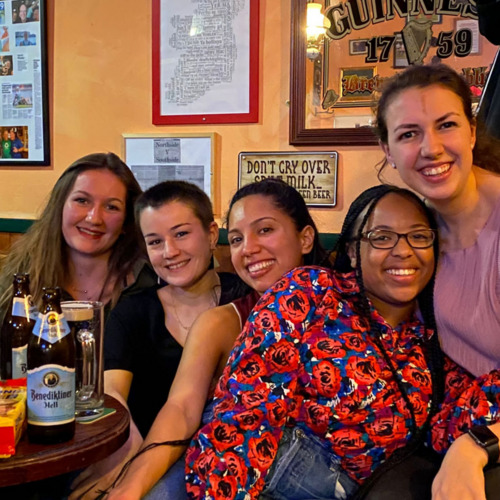
There are five stages of grief: denial, anger, bargaining, depression, and acceptance. Everyone may spend varying times in these stages, but each stage is integral, with acceptance being arguably the most important. Except this isn’t about experiencing a close death; it’s about refinding my identity as a Black woman living in an inherently White country. I would categorize my time in Austria as comprising five stages of identity that feel almost like the stages of grief. Moments where I was proud of my Blackness, where I got more in touch with my African identity. Yet there were also moments where I wanted to crawl out of my skin because I couldn’t tell if the looks of disgust were real or if my mind was playing tricks on me this time. I’d like to invite you to read the five stages of identity that I experienced in Austria.
Stage 1: Acknowledgement
Before moving to Austria, I knew I’d be one of a few Black people. In a country with only nine million people and roughly 40,000 of them Black, I knew what I had signed up for. Prior to moving to Austria, I had spent four years in a utopia called an HBCU (Historically Black Colleges and Universities). North Carolina Agricultural and Technical State University, a school built for Black folks who couldn’t get into the famed North Carolina State University during segregation and the Jim Crow era, was a safe space for Black folks who wanted to experience life and community with those who looked like them. After having completed my degree at an HBCU, I knew I would have massive culture shock in Austria.
I knew that Austria would be quite ignorant of the plight of Black folks. I knew they would make questionable comments, but since they were Europeans, I was expecting and ready to give them a pass. “It’s not a part of their history,” I said to myself, knowing the woes of the colonization of Africa that began on this very continent. I knew I would have to educate not only my students but also most people I interacted with. My HBCU had given me thick skin—though a type of thick skin different from the kind that we were assumed to have during Jim Crow and that was used as an excuse to whip and beat us. From my time at an HBCU, I gained the thickness to love my melanin and help others see what it truly means to be Black.
I knew Austria wouldn’t have hair care products for textured hair available in drug stores. I knew it would be difficult for me to find a hair braider. I knew Austria wouldn’t have the seasonings and spices that I use to cook soul food. So I did my research. I looked up “Being Black in Austria” on YouTube hoping I’d find a vlogger, and I did. The video gave me a forewarning about many things I had expected, such as being asked “Where are you REALLY from?” after you’ve told them where you were born—a situation that found me in Austria as early as my arrival at Vienna International Airport. I quickly messaged the Black YouTuber, who just so happened to live in Linz, the same city I was living in. I knew I’d need to be part of a community.
Stage 2: Pride
I began taking pride in my Blackness and my African roots. When talking with and meeting other Black folks, the question of “Where are you really from?” began to come up. It hits different when someone who looks like you says it. It doesn’t feel as dismissive or condescending as when a non-Black person says it; it feels like a true inquisitiveness so that we could connect on a deeper level. “Oh, my family comes from slavery, so I don’t really know,” I’d reply with this fleeting feeling of sorrow. I wish I could say something like “Ghana, and our Jollof is the best,” but instead the marks of colonialism were all over me. My lighter complexion meant that I was diluted, and my constant use of African American Vernacular English was the cherry on top.
They still accepted me for who I was, because even if I didn’t intrinsically know certain things to be African, I was still their kinfolk. So I started listening to Afrobeats. I was persistent in learning French to talk more with a friend from Côte d’Ivoire and his family. My aunt had even recently done an ancestry DNA test, so I had a better idea of where I was from. My answer changed from “I don’t really know” to “My ancestry is from primarily New Guinea, the Congo, and Cameroon.” I felt pride in my West African roots. Even if I wasn’t 100% sure, something felt better than nothing.
Black History Month was my time to shine. I sent a message to my teaching colleagues saying that in observance of Black History Month in February, all my lessons would be themed around it. Even if the students were working on a particular unit, I would incorporate Black history in some way, shape, or form. It was met with such positivity that I taught Black history until the end of March. Hearing my colleagues say “I never even knew about that” when discussing Emmett Till, the Black Panther Party, and the Tuskegee experiments let me know that I was actually doing something. Watching my students create protest posters when I taught them about police brutality and the importance of movements and organizing filled me with joy.
I felt like I was undoing years of possible miseducation, but I was also putting myself at risk in ways I didn’t realize. See, even in these moments of education, I had to have some tough conversations. Like telling my colleagues that referring to a group of Black people using the term “Blacks” was inappropriate. Or that saying the “N-word,” even if in an educational context, was still not acceptable. Or discussing with my class that no, even if this word is said in your favorite rap song, it doesn’t mean you get to say it. These conversations were draining but necessary. But I bottled up the feelings that I experienced during them, which would later come back to haunt me.
Stage 3: Anger
The feeling that I had bottled up and that eventually boiled over was anger. In these moments of sharing knowledge about and pride in Black history, I was also pushing down microaggressions.
I experienced my first form of direct racism just a few weeks into living in Austria. I was taking a walk with a friend who was also Black when someone leaned out of their car to yell “niggers” at us before speeding off. My friend was so angry that he couldn’t do anything about it. But my reaction was the opposite. I laughed and said “Oh wow” because to me it was comical. For me, it was the only appropriate reaction to have because racism is inescapable to the point that it’s laughable. But once my laughter died down, I began to realize that there would be even more moments like this. I hoped my laughter would be able to carry me throughout these painful moments.
I spent months dealing with small amounts of racism, stereotypes, and microaggressions. Being asked to do the rapping part of a karaoke song because it’s “second nature.” Being met with suspicion at stores and checkout counters until people heard my obvious American accent while speaking German. Having to hear many Austrians say “What? We’re not racist, we never had anything like segregation,” as if having children dress up in blackface on Epiphany is merely part of a tradition and could never be offensive.
When I had braids, it was insufferable. People touching them without even thinking to ask for permission, making comments, asking me questions. Sometimes I joked and said, “I should write a small leaflet with the title ‘All you need to know about my new hairstyle’ and pass it out to my colleagues.” (I also wanted to write a small leaflet titled “Why you shouldn’t wear braid extensions” and pass it out to all the non-Black women I saw, but that’s a different story.) The defensive arguments were even worse. “Well, why can’t I compliment your hair if it looks nice?” And my answer was never enough.
The worst moment was when I was having drinks with a group of international friends. We were having a conversation in English over a few beers when someone came up to us and said, “Where are you all from?” Everyone stopped and stared at me because it was obvious the American in our group had caught his attention. “I’m from the States,” I answered, hoping that a hate crime wouldn’t ensue. “You know what I think. Trump wasn’t really that bad. And in comparison to Obama…” he began to rant. I sat there dumbfounded that he would really have the audacity to randomly approach us. I repeatedly told him to leave and looked around at my group of friends for backup, and of the seven of us, only one other person had my back. Once the stranger left, I was so uncomfortable, and the group of people I was with used my discomfort as the butt of a joke. I was devastated. I began to repress myself because if my friends weren’t going to be there for me, why would I even bother.
Stage 4: Isolation
I felt alone. I felt like I was the only Black person everywhere I went. I would walk down the street and look around for other people who looked like me. Four other Black people on an average day, ten if I was lucky. In America, when Black people see each other in predominately White spaces, we smile or do a slight head nod. This small greeting means “I see you,” and it has provided me with so much comfort throughout life. But in Austria, I’d offer a smile or a nod and was met with a stillness that hurt. I asked myself, “What has this country done to my people that made them forget how warm we are?” We are not cold beings. I began to shut down. I too turned cold.
During my first summer in Europe, I cried so hard because I hated the way I looked. I was not the Austrian beauty standard, and I felt it. I had never struggled with self-confidence before. I know I’m beautiful, but Austria made me feel so ugly. I am the exact opposite of a tall, skinny, blonde-haired White woman. I am a short and curvy Black woman. If I wore shorts or a tank top, people would stare at me like I was an extraterrestrial being. “Is there something on my face?” I wondered as I patted myself down, hoping that I hadn’t been walking around with toilet paper on the bottom of my shoe or my shirt on backward. But nothing was there except for the same skin that I had been living in for over 20 years. I wanted to crawl out of it. I wanted to escape it just momentarily so I wouldn’t always feel like the odd one out. Just a few minutes so no one would question my belonging.
So I retreated. I spent days in my bedroom talking with loved ones and friends back home. I opened letters people had written me before I left. The affirming words and encouragement consoled my nearly broken spirit. They wiped away the tears I shed as I cried out, “I hate this, I want to go home.” The letters included statements like: “You’re brave,” “You’re courageous,” “You’re built different,” “We always knew you could.” I never saw moving out of the US as a brave thing to do until met with the adversities of solitude. So I took these words and honored my loved ones. I left my room.
Stage 5: Community
I left my room and sought a support system. A group of people who may not necessarily look like me but felt the same way as me. I found community through other teaching assistants (TAs) that were just like me: living in a foreign country, trying to get a grasp of the Austrian dialect, and dealing with waves of homesickness. I then found myself in a community that was so beautiful and ran so deep that I fostered friendships that I knew would last a lifetime.
A TA from Las Vegas, Nevada, introduced me to “the volleyball crew.” We were a group of young people—the majority from foreign countries, with a sprinkle of Austrians—who all found themselves in Austria for different reasons. Some people for work, others for study and, everyone’s favorite trope, for love. We’d meet at the Donaulände park in Linz on warm sunny days and enjoy a few matches of volleyball. Then our friendships grew off the courts and into game nights, potluck dinners, and even a road trip across eastern Europe.
A TA from Indiana introduced me to Chelsea Pub. This seemingly dingy Irish pub became my safe space. As I became a regular at the pub and good friends with all the bartenders, I’d run into other Americans and English speakers and over a few drinks, sports matches, and the weekly pub quiz, we shared more than laughs. The lasting memories we created at the pub are commemorated in a picture hung on the wall in our usual spot.
The USTA program network is so much bigger than just the network of TAs from the US. I also hung out with British and French TAs. We hosted crepe nights, Eurovision watch parties, and taco Tuesdays to share some of the most important aspects of our cultures. I traveled across Europe with a TA from Dallas, Texas, who was part of the program run in Spain by the Spanish educational ministry. We visited each other and instantly clicked. Five countries together later, he is one of my closest friends. But that’s the beauty of it all. The ability to instantly click over just one or two things in common. I think I was looking for someone who would be exactly like me, and I was disappointed when I didn’t find them. But when I met with other people and the only thing we had in common was that we both enjoyed anime or we both were interested in learning how to ski, I found my closest friends. Friendships that will transcend borders and time zone differences.
Reflections
Just like acceptance is the most important part of the grieving process, finding community is the most important part of the identity process. I went back and forth between all those feelings and emotions, but my community is what kept me grounded. Being in a community is what made my USTA experience more than worth it. It overshadows any of the hard moments because laughter and joy are louder than tears and sadness. The anger that I had initially felt was masked with a smile, but that doesn’t mean that mask can hold up forever. My feelings of anger and sadness were very real and ones that I never want to feel again. The support I received from my community really allowed me to smile through the pain. I am grateful for the USTA experience showing me how to appreciate my roots, connecting me with my closest friends, and helping me to find myself.
Read the original article on fulbright.at here.






